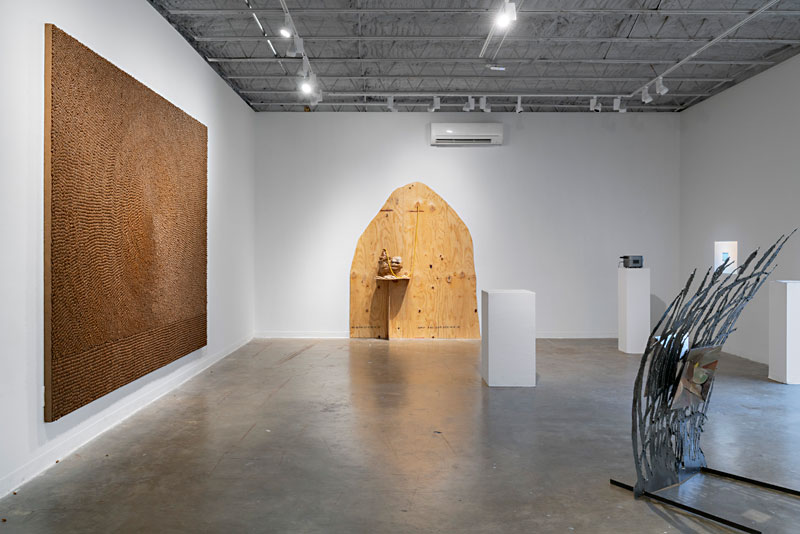
Diego Miró-Rivera’s Coemergence, Miles Matis-Uzzo’s Stillbody (Limestone), and Emily Lee’s Blind (photos courtesy of MASS Gallery)
We’re heading into yet another summer afflicted by a relentless drought, and critically low water flow at Barton Springs – the city’s holy wellspring – serves as a haunting reminder of its severity. Officials consistently ringing alarm bells about something so sacred to Austinites stirs feelings of despair, in line with the broader anxieties of a climate crisis that feels both achingly local and concerningly endless.
Thankfully, a band of Central Texas-based artists are here to tackle the complex emotions tied to our changing landscape. In the new exhibit “Porous Matters,” curated by Anahita (Ani) Bradberry for East Austin’s MASS Gallery, water – and the lack thereof – is reinterpreted through more romantic, and dare I say reverent, lenses.

Anika Todd’s Gauge 1 (Tom Miller Dam – Colorado River 4558) and Anahita (Ani) Bradberry’s Floodgate
Occupying spaces both in and outside the gallery, a small group of artists works with a range of materials – none of which, ironically, include water – to reflect on themes deeply personal to the Texas landscape. At the core of their artistic exploration is the Edwards Aquifer, the largest water source in Central Texas, and the changes in environment connected to the city’s prehistoric lifeline. Through metal and oil, plywood and perfume, and a moontower, a variety of materials frame a new relationship to the terrain, where art becomes the new landscape – framing not only the aquifer itself, but also the ever-evolving relationship Austinites have with the lifeblood beneath their feet.
First up is Emily Lee, a staple of Austin’s underground art scene. Her sculptural work Blind is a feat to behold: steel blowing in the wind. A material opposite to water, the steel is meticulously cut by the artist, assuming an upright, grasslike, shimmering form. But there’s more. The artist rewards curiosity when you crouch down to peer through the oil-painted square, perfectly framing the work of her peer Miles Matis-Uzzo’s multimedia installation, Stillbody (Limestone). Lee’s softly painted window not only acts as a visual conduit into Matis-Uzzo’s plywood, ceramic, and perfume-based work, but also as a gesture of homage – an act of admiration.
“Porous Matters” is, above all, an act of admiration – for Texas water, and for what is and once was.
The tones of reverence continue in Matis-Uzzo’s Stillbody (Limestone), where form, material, and scent come together in an act of veneration. A Madonna-shaped plywood altar upholds a clay amphora, which in turn cradles a single piece of Texas limestone – perfectly balanced, like a relic. But why, you might ask, does the rock appear permanently doused? And do you smell something? Matis-Uzzo’s unexpectedly soothing perfume of stagnant water, Stagnant Seep: Fever Bloom, has seeped through the layers of stone, transforming the sculpture into a part-olfactory experience – one that reframes the region’s low water levels from something tragic into something oddly tender, honoring both the native Texas rock and the scent of stillness.

Emily Lee’s Blind
Outside the gallery doors, site-specific works hide in plain sight – so stripped to their most essential material that they’re almost imperceptible. But it makes sense: when the land runs dry, so does the supply. In this scarcity, the immateriality of the two sculptural works blends into the contemporary urban environment, where the classic question – “Is it art, or is it a part of the landscape?” – reveals itself as both. This is exemplified in artist/curator Anahita Bradberry’s Floodgate, where five slender electrician’s poles, internally lit by red plasma, not only allude to its namesake, but also the quiet form of a Japanese shrine. The piece then becomes both a passageway and a place of contemplation, leading the viewer to the crux of the exhibition: Anika Todd’s Gauge 1 (Tom Miller Dam – Colorado River 4558).
Todd’s radio tower flickers in real time, its pulsing light responding to data from the dam’s website. Here, the signal reflects the constant flux of what we once thought of as a reliable resource. Standing quietly in the far corner like a thought pushed aside in our mind, the work becomes a looming reminder, a silent warning, that water and the Edwards Aquifer are certainly not guaranteed.
MASS’ “Porous Matters” is, above all, an act of admiration – for Texas water, and for what is and once was. These works, along with other video, text, and burlap-based works, embody not only this reverence for Texas water itself, but laterally, toward one another within the same shared space. In the end, it’s a lesson for everyone: to honor what we take for granted, and to uplift those around us who are trying, in their own way, to do the same.
“Porous Matters”
MASS Gallery
Through May 24
Editor’s Note: This review has been updated to reflect the correct names of the artworks pictured.
